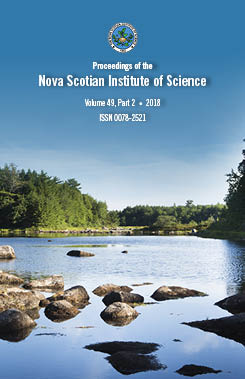Perspective on warm climate intervals and their history: How might coastal Canada adapt to an ocean-related and potentially negative impact of predicted warmer conditions?
DOI:
https://doi.org/10.15273/pnsis.v49i2.8160Abstract
Past warm intervals lasting from decades to centuries can be observed throughout the late Holocene geologic record using various proxy physical, chemical and fossil indices, in conjunction with seasonal information such as the timing of the first flowers of the spring season, or by the dates of first freezing and thaws of fresh water bodies, that have been recorded in various journals. Three important warm intervals that have been identified over the past 3500 years include the Late Bronze Age Optimum (BAO)(~1350 to ~1200 BC), the Iron/Roman Age Optimum (I/RAO)(~250 BC to ~400 AD) and the Medieval Warm Period (MWP)(~950 to ~1250 AD). The early phase of the BAO featured maximum development of the Hittite Empire and the evolution of the palace economy. The timing and duration of the later I/RAO show considerable variation from place to place in the Northern Hemisphere. MWP proxy records from several regions indicate that, like the I/RAO pattern, peak warmth occurred at different times in different places included in the Period‘s overall footprint. Paleo-temperatures, both slightly cooler and warmer than present, have been reported. The WMP occurred during the Middle Ages at a time of the expansion of major commercial routes along the Mediterranean Sea coast and during an interval when Vikings explored and settled in some areas of the North Atlantic region.
Sea level rise is among the suite of important ocean-related negative impacts that are often associated with contemporary global warming scenarios. Both early and modern societies have developed effective adaptation strategies and mitigation techniques to resist rising sea levels and flooding. Many of these have utility for Canada in both inland and especially in coastal areas of the Maritime Provinces. Early sea level rise and tidal flow mitigation measures include the construction of dykes around low-lying areas, sand dune stabilization and shoreline armoring using large boulders in concert with breakwaters and groynes. Today, there is also opportunity for the application of beach nourishment and artificial dune construction to resist erosion by storm waves and alongshore currents but these typically require annual maintenance to remain effective. Last resort mechanisms range from stilt home construction to abandonment (managed retreat) of previously impacted coastal areas. It is very likely that, when needed, Canadians will be able to apply a broad range of modern and ancient effective technologies and to engage engineering expertise to develop new (e.g., hybrid) approaches for combating specific negative coastal impacts than were available to BAO, I/RAO and MWP societies.


